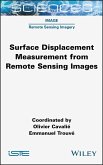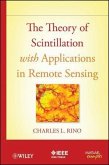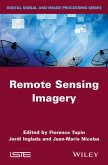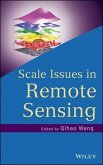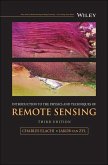Yajing Yan
Inversion and Data Assimilation in Remote Sensing (eBook, ePUB)
Estimation of Geophysical Parameters
142,99 €
142,99 €
inkl. MwSt.
Sofort per Download lieferbar

0 °P sammeln
142,99 €
Als Download kaufen

142,99 €
inkl. MwSt.
Sofort per Download lieferbar

0 °P sammeln
Jetzt verschenken
Alle Infos zum eBook verschenken
142,99 €
inkl. MwSt.
Sofort per Download lieferbar
Alle Infos zum eBook verschenken

0 °P sammeln
Yajing Yan
Inversion and Data Assimilation in Remote Sensing (eBook, ePUB)
Estimation of Geophysical Parameters
- Format: ePub
- Merkliste
- Auf die Merkliste
- Bewerten Bewerten
- Teilen
- Produkt teilen
- Produkterinnerung
- Produkterinnerung

Bitte loggen Sie sich zunächst in Ihr Kundenkonto ein oder registrieren Sie sich bei
bücher.de, um das eBook-Abo tolino select nutzen zu können.
Hier können Sie sich einloggen
Hier können Sie sich einloggen
Sie sind bereits eingeloggt. Klicken Sie auf 2. tolino select Abo, um fortzufahren.

Bitte loggen Sie sich zunächst in Ihr Kundenkonto ein oder registrieren Sie sich bei bücher.de, um das eBook-Abo tolino select nutzen zu können.
Remote sensing data are now the primary sources for observing Earth and the Universe. Data inversion and assimilation techniques are the main tools for estimating and predicting the geophysical parameters that characterize the evolution of our planet and the Universe, using remote sensing data.
Inversion and Data Assimilation in Remote Sensing explores recent advances in the inversion and assimilation of remote sensing data. It presents traditional and current neural network methods, as well as a number of topics where these methods have been developed or adapted to suit the specific…mehr
- Geräte: eReader
- mit Kopierschutz
- eBook Hilfe
- Größe: 18.3MB
Andere Kunden interessierten sich auch für
![Surface Displacement Measurement from Remote Sensing Images (eBook, ePUB) Surface Displacement Measurement from Remote Sensing Images (eBook, ePUB)]() Olivier CavalieSurface Displacement Measurement from Remote Sensing Images (eBook, ePUB)126,99 €
Olivier CavalieSurface Displacement Measurement from Remote Sensing Images (eBook, ePUB)126,99 €![The Theory of Scintillation with Applications in Remote Sensing (eBook, ePUB) The Theory of Scintillation with Applications in Remote Sensing (eBook, ePUB)]() Charles RinoThe Theory of Scintillation with Applications in Remote Sensing (eBook, ePUB)107,99 €
Charles RinoThe Theory of Scintillation with Applications in Remote Sensing (eBook, ePUB)107,99 €![Remote Sensing Imagery (eBook, ePUB) Remote Sensing Imagery (eBook, ePUB)]() Remote Sensing Imagery (eBook, ePUB)144,99 €
Remote Sensing Imagery (eBook, ePUB)144,99 €![Scale Issues in Remote Sensing (eBook, ePUB) Scale Issues in Remote Sensing (eBook, ePUB)]() Qihao WengScale Issues in Remote Sensing (eBook, ePUB)123,99 €
Qihao WengScale Issues in Remote Sensing (eBook, ePUB)123,99 €![Remote Sensing in Agriculture : Using Satellites for Crop Monitoring (eBook, ePUB) Remote Sensing in Agriculture : Using Satellites for Crop Monitoring (eBook, ePUB)]() Ruchini KaushalyaRemote Sensing in Agriculture : Using Satellites for Crop Monitoring (eBook, ePUB)5,99 €
Ruchini KaushalyaRemote Sensing in Agriculture : Using Satellites for Crop Monitoring (eBook, ePUB)5,99 €![Remote Sensing of Land Use and Land Cover (eBook, ePUB) Remote Sensing of Land Use and Land Cover (eBook, ePUB)]() Remote Sensing of Land Use and Land Cover (eBook, ePUB)65,95 €
Remote Sensing of Land Use and Land Cover (eBook, ePUB)65,95 €![Introduction to the Physics and Techniques of Remote Sensing (eBook, ePUB) Introduction to the Physics and Techniques of Remote Sensing (eBook, ePUB)]() Charles ElachiIntroduction to the Physics and Techniques of Remote Sensing (eBook, ePUB)130,99 €
Charles ElachiIntroduction to the Physics and Techniques of Remote Sensing (eBook, ePUB)130,99 €-
-
-
Remote sensing data are now the primary sources for observing Earth and the Universe. Data inversion and assimilation techniques are the main tools for estimating and predicting the geophysical parameters that characterize the evolution of our planet and the Universe, using remote sensing data.
Inversion and Data Assimilation in Remote Sensing explores recent advances in the inversion and assimilation of remote sensing data. It presents traditional and current neural network methods, as well as a number of topics where these methods have been developed or adapted to suit the specific nature of the field. The assimilation section covers prediction problems in volcanology and glaciology. Lastly, the inversion section covers biomass inversion using SAR images, bio-physio-hydrological inversion in coastal areas using multi- and hyperspectral images, and astrophysical inversion using telescope data.
Inversion and Data Assimilation in Remote Sensing explores recent advances in the inversion and assimilation of remote sensing data. It presents traditional and current neural network methods, as well as a number of topics where these methods have been developed or adapted to suit the specific nature of the field. The assimilation section covers prediction problems in volcanology and glaciology. Lastly, the inversion section covers biomass inversion using SAR images, bio-physio-hydrological inversion in coastal areas using multi- and hyperspectral images, and astrophysical inversion using telescope data.
Dieser Download kann aus rechtlichen Gründen nur mit Rechnungsadresse in D ausgeliefert werden.
Produktdetails
- Produktdetails
- Verlag: For Dummies
- Seitenzahl: 375
- Erscheinungstermin: 29. Oktober 2024
- Englisch
- ISBN-13: 9781394332281
- Artikelnr.: 72336901
- Verlag: For Dummies
- Seitenzahl: 375
- Erscheinungstermin: 29. Oktober 2024
- Englisch
- ISBN-13: 9781394332281
- Artikelnr.: 72336901
- Herstellerkennzeichnung Die Herstellerinformationen sind derzeit nicht verfügbar.
Yajing Yan is a lecturer at the LISTIC laboratory, Université Savoie Mont Blanc, France. Her research focuses on multi-temporal InSAR analysis, remote sensing data fusion and assimilation, and machine learning.
Preface xi
Yajing YAN
Part 1 Data Assimilation 1
Chapter 1 Methods for Assimilation of Observations: Application to
Numerical Weather Prediction 3
Olivier TALAGRAND
1.1. Introduction 3
1.2. The linear and Gaussian case 6
1.2.1. Variational form 8
1.3. Optimal interpolation - three-dimensional variational assimilation 10
1.4. Taking the dynamics of the flow into account 12
1.4.1. The Kalman Filter 16
1.4.2. Four-dimensional variational assimilation 22
1.4.3. Ensemble methods 27
1.4.4. Stability and instability 29
1.5. Particle filters 30
1.6. Artificial intelligence 32
1.7. Extensions and applications 33
1.8. References 34
Chapter 2 Ensemble Data Assimilation in Volcanology 39
Mary Grace BATO, Virginie PINEL and Yajing YAN
2.1. Volcano monitoring and eruption forecasting 39
2.2. Ensemble data assimilation 42
2.2.1. Volcanic data assimilation using the ensemble Kalman filter 43
2.2.2. The dynamic model 44
2.2.3. Data observations 47
2.3. Potentiality assessment of volcanic data assimilation for eruption
forecasting based on synthetic simulations 50
2.3.1. EnKF formulation 51
2.3.2. Synthetic observations 52
2.3.3. Experiment setup 53
2.3.4. Results and discussions 55
2.3.5. Implications to real-time volcano monitoring 61
2.4. Application: The 2004-2014 inter-eruptive activity at Grímsvötn
volcano, Iceland 62
2.4.1. Implications of the change in magma supply rate at Grímsvötn 64
2.5. Conclusions and outlook 65
2.6. Acknowledgments 66
2.7. References 66
Chapter 3 Data Assimilation in Glaciology 71
Fabien GILLET-CHAULET
3.1. Introduction 71
3.2. Predicting a paradigm shift for polar ice-sheet models 73
3.3. Principles of ice sheet dynamics 75
3.4. Parameter estimation 78
3.4.1. Variational methods 79
3.4.2. Bayesian methods 85
3.4.3. Classical inversion problems 85
3.5. State and parameter estimation 90
3.6. Conclusions and outlook 92
3.7. References 93
Part 2 Inversion 103
Chapter 4 Probabilistic Inversion Methods 105
Alexandrine GESRET
4.1. Local methods versus global methods 105
4.2. Bayesian formalism 107
4.3. Model parameterization 111
4.3.1. Layered models 112
4.3.2. Wavelets 113
4.3.3. Voronoi tessellation 115
4.3.4. The Johnson Mehl tessellation 116
4.4. Markov chain Monte Carlo-based sampling algorithms 118
4.4.1. The Metropolis-Hastings algorithm 121
4.4.2. Simulated annealing 123
4.4.3. Interacting Markov chains 125
4.4.4. The reversible jump Metropolis-Hastings algorithm 129
4.5. Conclusions and outlook 132
4.6. References 134
Chapter 5 Modeling Radar Backscattering from Forests: A First Step to
Inversion 139
Elise COLIN and Laetitia THIRION-LEFEVRE
5.1. Introduction 139
5.2. Vegetation model historical background 141
5.2.1. Evolution of measurements and their understanding 142
5.2.2. What should be remembered? And what prospects? 145
5.3. How to choose a model for inversion? 146
5.3.1. Different inversion approaches 146
5.3.2. Choosing according to the intended purpose 148
5.3.3. Validity and validation domain 152
5.3.4. Summarizing the choice of model 153
5.4. Biomass inversion 154
5.4.1. Challenges 154
5.4.2. Regression of backscatter coefficient curves 155
5.4.3. RVoG model in PolInSAR 156
5.4.4. Approximate model inversion 158
5.4.5. Metamodels 159
5.4.6. What should be remembered and expected? 160
5.5. Conclusions and outlook 160
5.6. References 163
Chapter 6 Radiative Transfer Model Inversion and Application to Coastal
Observation 169
Touria BAJJOUK, Audrey MINGHELLI, Malik CHAMI and Tristan PETIT
6.1. Introduction 169
6.2. Principle and treatment method 170
6.2.1. Inherent optical water properties 170
6.2.2. Apparent optical properties of water 171
6.3. Biophysical model of radiative transfer 172
6.3.1. Data and preprocessing 173
6.3.2. Estimation and inversion methods 176
6.3.3. Validation methods for inversion products 177
6.3.4. Uncertainty about inversion-estimated parameters 180
6.4. Examples of applications in coastal areas 182
6.4.1. SPM/CHL estimate 182
6.4.2. Bathymetry estimation 184
6.4.3. Spatial characterization of the seabed 187
6.5. Conclusions and outlook 190
6.6. References 193
Chapter 7 Deep-learning Analysis of Cherenkov Telescope Array Images 201
Mikaël JACQUEMONT, Thomas VUILLAUME, Alexandre BENOIT, Gilles MAURIN and
Patrick LAMBERT
7.1. Gamma astronomy 201
7.1.1. Gamma radiation and observation method 201
7.1.2. Analysis methods for Cherenkov images 204
7.2. Deep neural networks 205
7.2.1. Deep learning for gamma astronomy 206
7.2.2. Multitasking learning 207
7.2.3. Attention mechanisms 209
7.2.4. Explainability of neural networks 211
7.3. ¿-PhysNet: a multitasking architecture for the complete reconstruction
of gamma events 212
7.3.1. Encoder 212
7.3.2. Multitasking block 213
7.3.3. Improving the encoder with attention 214
7.4. Performance evaluation 215
7.4.1. Dataset 215
7.4.2. Data selection and preparation 217
7.4.3. Model training 217
7.4.4. Performance evaluation methodology 218
7.4.5. Interest of multitasking and comparison with the standard method 219
7.4.6. Energy regression 220
7.4.7. Direction regression 221
7.4.8. Impact of attention 222
7.4.9. Understanding the effect of attention on robustness 223
7.5. Conclusions and outlook 226
7.6. Acknowledgments 227
7.7. References 227
List of Authors 233
Index 235
Yajing YAN
Part 1 Data Assimilation 1
Chapter 1 Methods for Assimilation of Observations: Application to
Numerical Weather Prediction 3
Olivier TALAGRAND
1.1. Introduction 3
1.2. The linear and Gaussian case 6
1.2.1. Variational form 8
1.3. Optimal interpolation - three-dimensional variational assimilation 10
1.4. Taking the dynamics of the flow into account 12
1.4.1. The Kalman Filter 16
1.4.2. Four-dimensional variational assimilation 22
1.4.3. Ensemble methods 27
1.4.4. Stability and instability 29
1.5. Particle filters 30
1.6. Artificial intelligence 32
1.7. Extensions and applications 33
1.8. References 34
Chapter 2 Ensemble Data Assimilation in Volcanology 39
Mary Grace BATO, Virginie PINEL and Yajing YAN
2.1. Volcano monitoring and eruption forecasting 39
2.2. Ensemble data assimilation 42
2.2.1. Volcanic data assimilation using the ensemble Kalman filter 43
2.2.2. The dynamic model 44
2.2.3. Data observations 47
2.3. Potentiality assessment of volcanic data assimilation for eruption
forecasting based on synthetic simulations 50
2.3.1. EnKF formulation 51
2.3.2. Synthetic observations 52
2.3.3. Experiment setup 53
2.3.4. Results and discussions 55
2.3.5. Implications to real-time volcano monitoring 61
2.4. Application: The 2004-2014 inter-eruptive activity at Grímsvötn
volcano, Iceland 62
2.4.1. Implications of the change in magma supply rate at Grímsvötn 64
2.5. Conclusions and outlook 65
2.6. Acknowledgments 66
2.7. References 66
Chapter 3 Data Assimilation in Glaciology 71
Fabien GILLET-CHAULET
3.1. Introduction 71
3.2. Predicting a paradigm shift for polar ice-sheet models 73
3.3. Principles of ice sheet dynamics 75
3.4. Parameter estimation 78
3.4.1. Variational methods 79
3.4.2. Bayesian methods 85
3.4.3. Classical inversion problems 85
3.5. State and parameter estimation 90
3.6. Conclusions and outlook 92
3.7. References 93
Part 2 Inversion 103
Chapter 4 Probabilistic Inversion Methods 105
Alexandrine GESRET
4.1. Local methods versus global methods 105
4.2. Bayesian formalism 107
4.3. Model parameterization 111
4.3.1. Layered models 112
4.3.2. Wavelets 113
4.3.3. Voronoi tessellation 115
4.3.4. The Johnson Mehl tessellation 116
4.4. Markov chain Monte Carlo-based sampling algorithms 118
4.4.1. The Metropolis-Hastings algorithm 121
4.4.2. Simulated annealing 123
4.4.3. Interacting Markov chains 125
4.4.4. The reversible jump Metropolis-Hastings algorithm 129
4.5. Conclusions and outlook 132
4.6. References 134
Chapter 5 Modeling Radar Backscattering from Forests: A First Step to
Inversion 139
Elise COLIN and Laetitia THIRION-LEFEVRE
5.1. Introduction 139
5.2. Vegetation model historical background 141
5.2.1. Evolution of measurements and their understanding 142
5.2.2. What should be remembered? And what prospects? 145
5.3. How to choose a model for inversion? 146
5.3.1. Different inversion approaches 146
5.3.2. Choosing according to the intended purpose 148
5.3.3. Validity and validation domain 152
5.3.4. Summarizing the choice of model 153
5.4. Biomass inversion 154
5.4.1. Challenges 154
5.4.2. Regression of backscatter coefficient curves 155
5.4.3. RVoG model in PolInSAR 156
5.4.4. Approximate model inversion 158
5.4.5. Metamodels 159
5.4.6. What should be remembered and expected? 160
5.5. Conclusions and outlook 160
5.6. References 163
Chapter 6 Radiative Transfer Model Inversion and Application to Coastal
Observation 169
Touria BAJJOUK, Audrey MINGHELLI, Malik CHAMI and Tristan PETIT
6.1. Introduction 169
6.2. Principle and treatment method 170
6.2.1. Inherent optical water properties 170
6.2.2. Apparent optical properties of water 171
6.3. Biophysical model of radiative transfer 172
6.3.1. Data and preprocessing 173
6.3.2. Estimation and inversion methods 176
6.3.3. Validation methods for inversion products 177
6.3.4. Uncertainty about inversion-estimated parameters 180
6.4. Examples of applications in coastal areas 182
6.4.1. SPM/CHL estimate 182
6.4.2. Bathymetry estimation 184
6.4.3. Spatial characterization of the seabed 187
6.5. Conclusions and outlook 190
6.6. References 193
Chapter 7 Deep-learning Analysis of Cherenkov Telescope Array Images 201
Mikaël JACQUEMONT, Thomas VUILLAUME, Alexandre BENOIT, Gilles MAURIN and
Patrick LAMBERT
7.1. Gamma astronomy 201
7.1.1. Gamma radiation and observation method 201
7.1.2. Analysis methods for Cherenkov images 204
7.2. Deep neural networks 205
7.2.1. Deep learning for gamma astronomy 206
7.2.2. Multitasking learning 207
7.2.3. Attention mechanisms 209
7.2.4. Explainability of neural networks 211
7.3. ¿-PhysNet: a multitasking architecture for the complete reconstruction
of gamma events 212
7.3.1. Encoder 212
7.3.2. Multitasking block 213
7.3.3. Improving the encoder with attention 214
7.4. Performance evaluation 215
7.4.1. Dataset 215
7.4.2. Data selection and preparation 217
7.4.3. Model training 217
7.4.4. Performance evaluation methodology 218
7.4.5. Interest of multitasking and comparison with the standard method 219
7.4.6. Energy regression 220
7.4.7. Direction regression 221
7.4.8. Impact of attention 222
7.4.9. Understanding the effect of attention on robustness 223
7.5. Conclusions and outlook 226
7.6. Acknowledgments 227
7.7. References 227
List of Authors 233
Index 235
Preface xi
Yajing YAN
Part 1 Data Assimilation 1
Chapter 1 Methods for Assimilation of Observations: Application to
Numerical Weather Prediction 3
Olivier TALAGRAND
1.1. Introduction 3
1.2. The linear and Gaussian case 6
1.2.1. Variational form 8
1.3. Optimal interpolation - three-dimensional variational assimilation 10
1.4. Taking the dynamics of the flow into account 12
1.4.1. The Kalman Filter 16
1.4.2. Four-dimensional variational assimilation 22
1.4.3. Ensemble methods 27
1.4.4. Stability and instability 29
1.5. Particle filters 30
1.6. Artificial intelligence 32
1.7. Extensions and applications 33
1.8. References 34
Chapter 2 Ensemble Data Assimilation in Volcanology 39
Mary Grace BATO, Virginie PINEL and Yajing YAN
2.1. Volcano monitoring and eruption forecasting 39
2.2. Ensemble data assimilation 42
2.2.1. Volcanic data assimilation using the ensemble Kalman filter 43
2.2.2. The dynamic model 44
2.2.3. Data observations 47
2.3. Potentiality assessment of volcanic data assimilation for eruption
forecasting based on synthetic simulations 50
2.3.1. EnKF formulation 51
2.3.2. Synthetic observations 52
2.3.3. Experiment setup 53
2.3.4. Results and discussions 55
2.3.5. Implications to real-time volcano monitoring 61
2.4. Application: The 2004-2014 inter-eruptive activity at Grímsvötn
volcano, Iceland 62
2.4.1. Implications of the change in magma supply rate at Grímsvötn 64
2.5. Conclusions and outlook 65
2.6. Acknowledgments 66
2.7. References 66
Chapter 3 Data Assimilation in Glaciology 71
Fabien GILLET-CHAULET
3.1. Introduction 71
3.2. Predicting a paradigm shift for polar ice-sheet models 73
3.3. Principles of ice sheet dynamics 75
3.4. Parameter estimation 78
3.4.1. Variational methods 79
3.4.2. Bayesian methods 85
3.4.3. Classical inversion problems 85
3.5. State and parameter estimation 90
3.6. Conclusions and outlook 92
3.7. References 93
Part 2 Inversion 103
Chapter 4 Probabilistic Inversion Methods 105
Alexandrine GESRET
4.1. Local methods versus global methods 105
4.2. Bayesian formalism 107
4.3. Model parameterization 111
4.3.1. Layered models 112
4.3.2. Wavelets 113
4.3.3. Voronoi tessellation 115
4.3.4. The Johnson Mehl tessellation 116
4.4. Markov chain Monte Carlo-based sampling algorithms 118
4.4.1. The Metropolis-Hastings algorithm 121
4.4.2. Simulated annealing 123
4.4.3. Interacting Markov chains 125
4.4.4. The reversible jump Metropolis-Hastings algorithm 129
4.5. Conclusions and outlook 132
4.6. References 134
Chapter 5 Modeling Radar Backscattering from Forests: A First Step to
Inversion 139
Elise COLIN and Laetitia THIRION-LEFEVRE
5.1. Introduction 139
5.2. Vegetation model historical background 141
5.2.1. Evolution of measurements and their understanding 142
5.2.2. What should be remembered? And what prospects? 145
5.3. How to choose a model for inversion? 146
5.3.1. Different inversion approaches 146
5.3.2. Choosing according to the intended purpose 148
5.3.3. Validity and validation domain 152
5.3.4. Summarizing the choice of model 153
5.4. Biomass inversion 154
5.4.1. Challenges 154
5.4.2. Regression of backscatter coefficient curves 155
5.4.3. RVoG model in PolInSAR 156
5.4.4. Approximate model inversion 158
5.4.5. Metamodels 159
5.4.6. What should be remembered and expected? 160
5.5. Conclusions and outlook 160
5.6. References 163
Chapter 6 Radiative Transfer Model Inversion and Application to Coastal
Observation 169
Touria BAJJOUK, Audrey MINGHELLI, Malik CHAMI and Tristan PETIT
6.1. Introduction 169
6.2. Principle and treatment method 170
6.2.1. Inherent optical water properties 170
6.2.2. Apparent optical properties of water 171
6.3. Biophysical model of radiative transfer 172
6.3.1. Data and preprocessing 173
6.3.2. Estimation and inversion methods 176
6.3.3. Validation methods for inversion products 177
6.3.4. Uncertainty about inversion-estimated parameters 180
6.4. Examples of applications in coastal areas 182
6.4.1. SPM/CHL estimate 182
6.4.2. Bathymetry estimation 184
6.4.3. Spatial characterization of the seabed 187
6.5. Conclusions and outlook 190
6.6. References 193
Chapter 7 Deep-learning Analysis of Cherenkov Telescope Array Images 201
Mikaël JACQUEMONT, Thomas VUILLAUME, Alexandre BENOIT, Gilles MAURIN and
Patrick LAMBERT
7.1. Gamma astronomy 201
7.1.1. Gamma radiation and observation method 201
7.1.2. Analysis methods for Cherenkov images 204
7.2. Deep neural networks 205
7.2.1. Deep learning for gamma astronomy 206
7.2.2. Multitasking learning 207
7.2.3. Attention mechanisms 209
7.2.4. Explainability of neural networks 211
7.3. ¿-PhysNet: a multitasking architecture for the complete reconstruction
of gamma events 212
7.3.1. Encoder 212
7.3.2. Multitasking block 213
7.3.3. Improving the encoder with attention 214
7.4. Performance evaluation 215
7.4.1. Dataset 215
7.4.2. Data selection and preparation 217
7.4.3. Model training 217
7.4.4. Performance evaluation methodology 218
7.4.5. Interest of multitasking and comparison with the standard method 219
7.4.6. Energy regression 220
7.4.7. Direction regression 221
7.4.8. Impact of attention 222
7.4.9. Understanding the effect of attention on robustness 223
7.5. Conclusions and outlook 226
7.6. Acknowledgments 227
7.7. References 227
List of Authors 233
Index 235
Yajing YAN
Part 1 Data Assimilation 1
Chapter 1 Methods for Assimilation of Observations: Application to
Numerical Weather Prediction 3
Olivier TALAGRAND
1.1. Introduction 3
1.2. The linear and Gaussian case 6
1.2.1. Variational form 8
1.3. Optimal interpolation - three-dimensional variational assimilation 10
1.4. Taking the dynamics of the flow into account 12
1.4.1. The Kalman Filter 16
1.4.2. Four-dimensional variational assimilation 22
1.4.3. Ensemble methods 27
1.4.4. Stability and instability 29
1.5. Particle filters 30
1.6. Artificial intelligence 32
1.7. Extensions and applications 33
1.8. References 34
Chapter 2 Ensemble Data Assimilation in Volcanology 39
Mary Grace BATO, Virginie PINEL and Yajing YAN
2.1. Volcano monitoring and eruption forecasting 39
2.2. Ensemble data assimilation 42
2.2.1. Volcanic data assimilation using the ensemble Kalman filter 43
2.2.2. The dynamic model 44
2.2.3. Data observations 47
2.3. Potentiality assessment of volcanic data assimilation for eruption
forecasting based on synthetic simulations 50
2.3.1. EnKF formulation 51
2.3.2. Synthetic observations 52
2.3.3. Experiment setup 53
2.3.4. Results and discussions 55
2.3.5. Implications to real-time volcano monitoring 61
2.4. Application: The 2004-2014 inter-eruptive activity at Grímsvötn
volcano, Iceland 62
2.4.1. Implications of the change in magma supply rate at Grímsvötn 64
2.5. Conclusions and outlook 65
2.6. Acknowledgments 66
2.7. References 66
Chapter 3 Data Assimilation in Glaciology 71
Fabien GILLET-CHAULET
3.1. Introduction 71
3.2. Predicting a paradigm shift for polar ice-sheet models 73
3.3. Principles of ice sheet dynamics 75
3.4. Parameter estimation 78
3.4.1. Variational methods 79
3.4.2. Bayesian methods 85
3.4.3. Classical inversion problems 85
3.5. State and parameter estimation 90
3.6. Conclusions and outlook 92
3.7. References 93
Part 2 Inversion 103
Chapter 4 Probabilistic Inversion Methods 105
Alexandrine GESRET
4.1. Local methods versus global methods 105
4.2. Bayesian formalism 107
4.3. Model parameterization 111
4.3.1. Layered models 112
4.3.2. Wavelets 113
4.3.3. Voronoi tessellation 115
4.3.4. The Johnson Mehl tessellation 116
4.4. Markov chain Monte Carlo-based sampling algorithms 118
4.4.1. The Metropolis-Hastings algorithm 121
4.4.2. Simulated annealing 123
4.4.3. Interacting Markov chains 125
4.4.4. The reversible jump Metropolis-Hastings algorithm 129
4.5. Conclusions and outlook 132
4.6. References 134
Chapter 5 Modeling Radar Backscattering from Forests: A First Step to
Inversion 139
Elise COLIN and Laetitia THIRION-LEFEVRE
5.1. Introduction 139
5.2. Vegetation model historical background 141
5.2.1. Evolution of measurements and their understanding 142
5.2.2. What should be remembered? And what prospects? 145
5.3. How to choose a model for inversion? 146
5.3.1. Different inversion approaches 146
5.3.2. Choosing according to the intended purpose 148
5.3.3. Validity and validation domain 152
5.3.4. Summarizing the choice of model 153
5.4. Biomass inversion 154
5.4.1. Challenges 154
5.4.2. Regression of backscatter coefficient curves 155
5.4.3. RVoG model in PolInSAR 156
5.4.4. Approximate model inversion 158
5.4.5. Metamodels 159
5.4.6. What should be remembered and expected? 160
5.5. Conclusions and outlook 160
5.6. References 163
Chapter 6 Radiative Transfer Model Inversion and Application to Coastal
Observation 169
Touria BAJJOUK, Audrey MINGHELLI, Malik CHAMI and Tristan PETIT
6.1. Introduction 169
6.2. Principle and treatment method 170
6.2.1. Inherent optical water properties 170
6.2.2. Apparent optical properties of water 171
6.3. Biophysical model of radiative transfer 172
6.3.1. Data and preprocessing 173
6.3.2. Estimation and inversion methods 176
6.3.3. Validation methods for inversion products 177
6.3.4. Uncertainty about inversion-estimated parameters 180
6.4. Examples of applications in coastal areas 182
6.4.1. SPM/CHL estimate 182
6.4.2. Bathymetry estimation 184
6.4.3. Spatial characterization of the seabed 187
6.5. Conclusions and outlook 190
6.6. References 193
Chapter 7 Deep-learning Analysis of Cherenkov Telescope Array Images 201
Mikaël JACQUEMONT, Thomas VUILLAUME, Alexandre BENOIT, Gilles MAURIN and
Patrick LAMBERT
7.1. Gamma astronomy 201
7.1.1. Gamma radiation and observation method 201
7.1.2. Analysis methods for Cherenkov images 204
7.2. Deep neural networks 205
7.2.1. Deep learning for gamma astronomy 206
7.2.2. Multitasking learning 207
7.2.3. Attention mechanisms 209
7.2.4. Explainability of neural networks 211
7.3. ¿-PhysNet: a multitasking architecture for the complete reconstruction
of gamma events 212
7.3.1. Encoder 212
7.3.2. Multitasking block 213
7.3.3. Improving the encoder with attention 214
7.4. Performance evaluation 215
7.4.1. Dataset 215
7.4.2. Data selection and preparation 217
7.4.3. Model training 217
7.4.4. Performance evaluation methodology 218
7.4.5. Interest of multitasking and comparison with the standard method 219
7.4.6. Energy regression 220
7.4.7. Direction regression 221
7.4.8. Impact of attention 222
7.4.9. Understanding the effect of attention on robustness 223
7.5. Conclusions and outlook 226
7.6. Acknowledgments 227
7.7. References 227
List of Authors 233
Index 235

